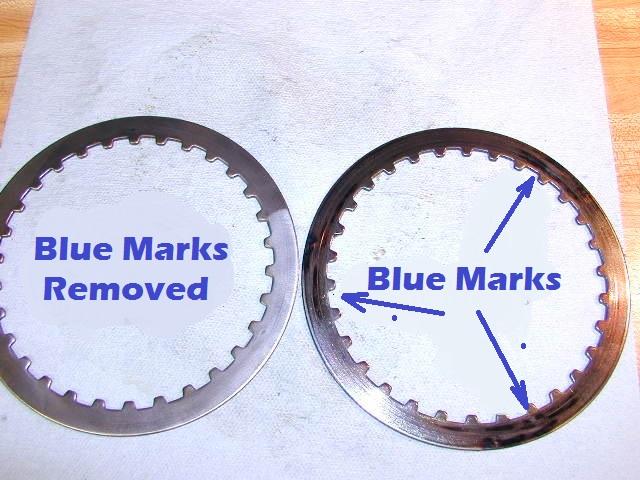-
Posts
2,432 -
Joined
-
Last visited
-
Days Won
50
Content Type
Forums
Profiles
Gallery
Blogs
Downloads
Events
Everything posted by BusyLittleShop
-
I've been using Lithium Iron batteries since 2009... First was the (SpeedCell) since sold to a customer... currently Mr.RC45 is powered by a Shoria... I think days of the old heavy lead acid battery are number... smart money is on the new light weight Lithium Iron battery...
-
Nothing wrong with Honda except the CEO in control... he is the account that closes his wallet with a torque wrench towards any new race bred V4...
-

looking for a peg lowering kit for my 6 gen
BusyLittleShop replied to birddseedd's topic in Sixth Generation VFR's
Thanks Dangeruss... I'm happy you're happy... I hope customs didn't charge a fee??? -
Fact 1... Tires are elastic bodies and cannot be produced absolutely round without imbalance. Therefore balance is paramount after fitting a new tire... Fact 2... Dynamic balancing is the preferred method because the wheel is rotating and measures the deviation of masses with respect to center... How much weight is too much??? if you employ more than 3.5 ounces of lead weight which is 14 1/4 stick on lead weights to the tire it can be judged defective in manufacturing and you may request a refund or replacement... contact the seller and state your gripe...
-
Most major oil companies say to NEVER EVER add anything to their oils, because doing so will upset the oil’s carefully balanced additive package that was designed by their Chemical Engineers... I generally recommend that people choose a motor oil that is highly ranked to begin with, that doesn’t need any additional help. And to use that oil just as it comes, right out of the bottle, with no aftermarket additives at all...
-
The majority of auto oils meet or exceed Honda's oil specs mentioned in the manual... the offical oil of VFRD is still 5w30 M1 Auto...
-
There is no moly in Liqui-Moly... the proof is in the virgin oil sample... its a mechanical not an oil problem...
-
To visually check for clutch plate travel open the oil filler and pear inside and note what degree the plates follow the actuation of the lever... Keeping working on it until you note a quick and abundant spread... Here are the steps how to check for unwanted clutch drag with the engine running... 1 Place your bike on the center stand... 2 Start engine and establish a steady idle at 212ºF (operating temp)... 3 Squeeze in the clutch lever and shift into first gear... 4 Continue holding in the clutch lever and note if the rear wheel coast to stop or not... if it continues spinning that's unwanted drag... Ultimately you want the rear wheel to coast to a stop when the engine is idling and first gear selected with the clutch lever is squeezed in... .
-
Honda's great V2 experiment... but times have changed... V2s are no longer a part of any manufactures racing plans... the old work horse has been retired...
-
Honda produced enough RC213 to homologate but the CEO of Honda didn't follow up with the paper work... much to the disappointment of HRC engineers... 2020 CycleWorld Kevin Cameron HRC We asked Kuwata why Honda's MotoGP bike has V-4 power yet the new Fireblade is an inline? "This question is the most difficult!" Kuwata said, with a laugh. "Because the market is smaller [for big sportbikes] , it is very difficult to make two types of bikes in one category. We had V-4 RVF superbikes in the past, but for myself, I would like to have both. Many reasons for not having both-it's not a technical decision but a business one. Best to ask the sales department!"
-
Cut my wrist and it will bleed Honda red but HRC engineers have run out of Rs they need a V... Honda's pedestrian I4 street bike labors in the shadow of MotoGp technology as their MotoGp race bred V4 sits on the side lines... Throw me in coach, I'm ready to go... [youtube] [/youtube]
-

VF500F2 Aka MBD Incubation Period At Least 52 Years
BusyLittleShop replied to Dutchy's topic in Earlier VFRs
Mercy!!! -
Dowco is good but I think Honda's cover is better... $107 https://www.ebay.com/itm/GENUINE-HONDA-OEM-2004-18-CBR600-CBR1000-RACING-MOTORCYCLE-COVER-0SP34-MFJ-200/173862845357?ssPageName=STRK%3AMEBIDX%3AIT&_trksid=p2060353.m1438.l2649
-
High mileage is the constant where all clutches begin to loose grip due to normal glazing and contaminates that build up over use... If you wish high mileage clutch life then you have to invest is some good old sweat equity... because at the first sign of slip it doesn't automatically mean your clutch is tired and worn out or that your clutch plates are wore too thin because you can Mic them to determine serviceability and within the factory specifications... Under scrutiny you'll find that your slip was due to normal glazing and contaminates... Deglazing clutch plates ain't nothing new... it use to be part of every savvy rider's maintenance plan... and for some reason that all change... why fix what you can buy new is the what you hear now a days... but if your interested in making your clutch bite good as new then roll up your sleeves and read on... Inspect the friction plates for glazing... make sure you have plenty of material to work with... your shop manual states clutch thickness in thousands of an inch or mm... First removed the contaminants with Acetone... pick a hard surface to lay over a 600 grit black dry emery paper... rotate the clutch plate in a circle... you're just busting the glaze... don't get carried away remove too much material... You should end up with a friction plate looks dull like a new one as opposed to a shinny glazed one... recheck thickness... Next check the pressure plates for bluing caused by localized heat... make sure they are not warped... consult the manual for a thickness range... now removed the contaminants with Acetone and wire wheeled them to erased the blue and also to generally scuff up the surface... you should end up with a dull surface free of Blue marks... https://www.vfrdiscussion.com/uploads/monthly_2020_06/PressurePlates2.jpg.4d1e496dbcbcbb383730a9ab807432c9.jpg Bike on its side is a simple way to shift the oil level to an angle in order to remove the clutch cover without spillage... Have a new gasket standing by...
-
Weakest link in the whole electrical system is the battery... Smart money is on the new light weight Lithium Iron battery like Shorai or Anti Gravity...
-
You're welcome...
- 12 replies
-
- maintenance
- project
-
(and 2 more)
Tagged with:
-
STEERING HEAD BEARINGS Whether you employ ball or taper bearings the first sign that your steering head bearings are loose will be felt through the bars as a pronounce clunk during hard braking... Then again if your steering head bearings are too tight the bike will weave and not seek it own center... To achieve perfect torque first raise the front wheel off the ground... next tighten the steering head bearings until the bars lock... and finally back off the nut until the bars free wheel with a slight drag... with this method you find that sweat spot and avoid over tightening and under tightening even if you upgrade to taper roller bearings...
- 12 replies
-
- 1
-

-
- maintenance
- project
-
(and 2 more)
Tagged with:
-

Beeping sound when riding two-up
BusyLittleShop replied to eNiMaLx's topic in Sixth Generation VFR's
I have some ideas but post a video so we can hear the beep... -

looking for a peg lowering kit for my 6 gen
BusyLittleShop replied to birddseedd's topic in Sixth Generation VFR's
PEG BLOCKS a VFRD exclusive product are designed to keep your knees in the breeze... Peg Blocks are specially designed using billet 6061 T6 aluminum for the VFR800 years (5th Gen 98 to 01) and (6th Gen 02 on 09) and (8th Gen 14 on up)... they will effectively lower Honda's foot peg 1.5 inches (38mm) from the stock position... The price+ USPS flat rate priority shipping are as follows... as soon as I receive Pay Pal payment the shipping starts... my account netters2@comcast.net USA Peg Blocks $85.00 + Priority Shipping $8.30 = $93.30 Canada Peg Blocks $85.00 + Priority Shipping $27.90 = $112.90 Europe Peg Blocks $85.00 + Priority Shipping $38.60 = $123.60 Australia or Denmark $85.00 + Priority Shipping $39.60 = $124.60 What you see is what you get... Peg Block Instructions Print Out Rob's INSTALLATION GUIDE http://www.vfrdiscussion.com/index.php/topic/34097-bls-footpeg-block-install/ VFRD site http://www.vfrdiscussion.com/index.php?/topic/80155-peg-lowering-blocks-an-vfrd-exclusive-product/ -
Mercy!!! what you're doing is exactly what a oil cooled clutch was designed for so rev it up and have a wheelie nice day... there is no good reason to change your habits... what might be happening is hot spots which is normal when you sit at a light with the bike in gear and the clutch lever is holding the plates open... have a look at steel plates the next time you have the cover off and note any blue marks like the ones you see on my RC45 due to its racing intent use of a slipper clutch...
-

Mileage Let's Rock'em 'til the wheels fall off...
BusyLittleShop replied to RC79NC001's topic in Eighth Generation VFR's
No doubt Bailey miles are never in moderation... 100K Bailey miles equals 300K normal miles... I gather you're still running 5w30 Mobil 1??? -

Mileage Let's Rock'em 'til the wheels fall off...
BusyLittleShop replied to RC79NC001's topic in Eighth Generation VFR's
Thanks Sparkie... I saved your photos for my next BITOG oil viscosity debate... -

Mileage Let's Rock'em 'til the wheels fall off...
BusyLittleShop replied to RC79NC001's topic in Eighth Generation VFR's
Hiya Mike... is that 30 grade for both??? -

Mileage Let's Rock'em 'til the wheels fall off...
BusyLittleShop replied to RC79NC001's topic in Eighth Generation VFR's






